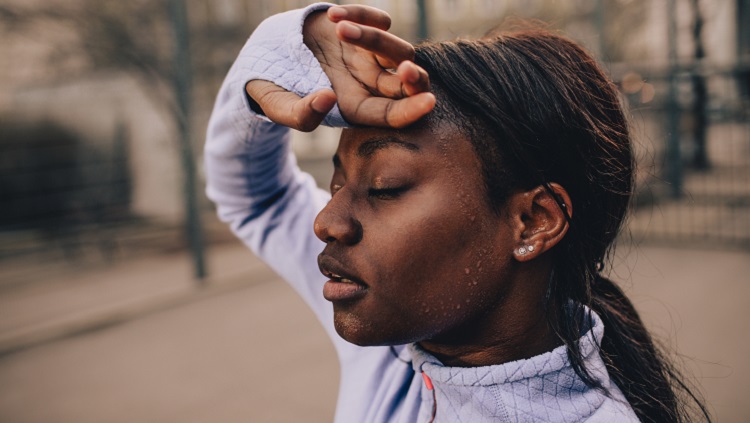How Does The Skin Help Regulate Body Temperature?
How Does the Body Regulate Temperature?
- Published 8 Oct 2020
- Author Michael Westward. Richardson
- Source BrainFacts/SfN

Istock.com/AleksandarNakic
When selecting an outfit for the day, you might turn to your phone, Tv set, or nearest window to bank check the weather. A x-degree temperature shift could hateful the deviation between grabbing a light jacket or rolling up your sleeves on a squeamish 24-hour interval.
Your trunk is even more vigilant nearly regulating and tracking its internal temperature. Neuroscientist Shaun Morrison of Oregon Wellness & Science University explains how the torso and encephalon regulate temperature, and what happens when things go awry.
How is the brain involved in temperature regulation?
Torso temperature regulation is like a reflex. You're non witting of it. The average healthy human torso maintains an internal temperature of around 37 degrees Celsius (98.five degrees Fahrenheit), though individuals tin vary slightly. The body makes tiny shifts and changes that keep it at a healthy temperature depending on the environment and the torso'southward output.
In the brain, the hypothalamus controls this reflex. It also plays roles in hormone secretion, sleep, and other functions. The hypothalamus receives input from temperature receptors in the pare and internal organs, including the gut.
Fifty-fifty at residuum in a temperate environs, your hypothalamus remains vigilant. Muscles produce a huge amount of rut when they're working, including the heart, guts, and even the diaphragm muscles that enable animate. Maintaining a proper body temperature is a total-time job, even when it seems like you aren't actively working any muscles.
When body temperature rises, what are the major risks?
The body's cells are very susceptible to high temperatures. As temperature rises above 40 degrees Celsius (104 degrees Fahrenheit), the proteins in cells can get-go to unravel. This tin can impairs cell office and can somewhen lead to jail cell death. In the brain, this can have long-term consequences, including permanent brain damage.
Reduced part of the heart muscle tin be a real danger. As torso temperature rises, the centre works harder to pump blood to the periphery to absurd the body. Equally the heart muscle weakens, cardiac output falls and oxygen supply to the organs, including the brain, is reduced.
The biggest danger in a hot surroundings is dehydration and reduced claret flow to the encephalon. The wet in sweat comes from water in the blood. If this water is not replenished by drinking, which could happen in a desert environment, and so claret book will decrease. This leads to reduced cardiac output and reduced blood catamenia to the brain.
When the heart suddenly slows, claret period to other organs will also driblet. If blood flow to the brain drops too much, victims of heatstroke will faint. This is an adaptive technique — it's much easier for the heart to pump blood to the brain when you lot're flat on the ground.
What happens when torso temperature falls?
Falling body temperature is much less dangerous than rising temperature. While high temperatures can apace cause cell death, low body temperature doesn't have the same effect. That's why some mammals can enter periods of hibernation where their internal temperatures drib significantly. While bears' internal temperatures may only driblet a few degrees during their slumber, the Chill ground squirrel's temperature can drop close to freezing, though merely for a few weeks. Humans don't have that ability, hypothermia sets in well earlier then.
In low temperatures, cellular role begins to slow. Humans may become dislocated or disoriented. Those are signs that neurons in the cerebrum or cognitive cortex aren't sending signals equally they should. But the main danger isn't cognition. Like heatstroke, hypothermia's threat lies in the middle and the encephalon areas regulating it. As internal temperature drops to dangerous levels, heartbeat regulation degrades. Victims develop arrhythmias — irregular heartbeats that alter blood flow to the remainder of the body. If blood isn't pumped to central organs, specially the brain, and then you're in trouble. Cardiac arrhythmias leading to cardiac abort seem to be what kills almost people who die of exposure.
BrainFacts.org welcomes all your brain-related questions.
Every month, we choose one reader question and get an reply from a elevation neuroscientist. Always been curious almost something?
Source: https://www.brainfacts.org/brain-anatomy-and-function/body-systems/2020/how-does-the-body-regulate-temperature-100720
Posted by: smithsualind.blogspot.com



0 Response to "How Does The Skin Help Regulate Body Temperature?"
Post a Comment